Employment and Disability
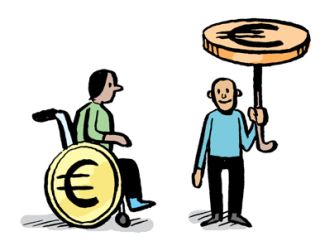
This Saturday, 3rd December 2022, is International Day of Persons with Disabilities. In this article we look at the interaction between disability and employment.
643,131 people with a disability in Ireland as of the last Census – that’s 13.5% of the population. This represented an increase of 47,796 persons (8%) on the 2011 figure of 595,335. In 2016, 311,580 (48.4%) persons with a disability were male while 331,551 (51.6%) were female.
The most common disability was a difficulty with pain, breathing or other chronic illness which was experienced by 46.1 per cent of all people with a disability. This was followed by a difficulty with basic physical activities, experienced by 40.9 per cent. The report found that both these disabilities were strongly age-related.
Census 2016 shows that people with a disability ceased their full-time education at an earlier age than the total population with 6,335 (5.4%) disabled persons aged 15 to 50 (inclusive) having left full-time education before reaching the age of 15, compared with 1.9 per cent for the State. Also, almost 47 per cent of disabled persons had finished their education between the ages of 15 and 18, compared with 37.7 per cent of the general population (see Chart 1).
According to the European Commission 2022 Country Report on Ireland, Ireland had higher than average early school leaving rates for people with disabilities (27.8 % vs the EU average of 23.6 %). Ireland has one of the widest early school leaving gaps between people with and without disabilities in the EU (22.5 percentage points vs the EU average of 12.6 percentage points).
The tertiary education attainment gap between people with and without disabilities is much wider than the EU average (24.6 percentage points vs the EU average of 13.2 percentage points), which aggravates inequalities in terms of access to employment and participation in society by this group.
Chart 1: Persons with a disability and total population aged 15-50 whose education has ceased classified by education attained, 2016.
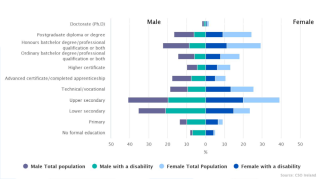
There were 176,445 persons with a disability in the labour force giving a labour force participation rate of 30.2 per cent, compared with a rate of 61.4 per cent for the overall population. However, given the disproportionally large number of people aged 65 and over among the disabled population (34.9% compared with 13.4% of the general population), it is informative to examine the data for those aged 15 to 64 only. Among the total population in this age group participation rates were 78 per cent for men and 65.9 for women, while for those with disabilities the rates were 51.1 per cent and 42.2 per cent respectively.
Chart 2 shows the labour force participation rates by age. Top two lines are the male and female participation rates of the general population and the bottom two lines are the male and female participation rates of persons with a disability. The peak ages for labour force participation for those with disabilities were 30-34 years for men at 68.6 per cent, and 25-29 for women at 63.4 per cent. In the general population, the male participation rate peaks between 30-34 years at 93.1 per cent, while female participation peaks at 82.7 per cent between the ages of 30 and 34.
Chart 2: Labour Force participation rate for persons aged 15 and over by gender, 2016
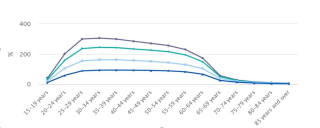
Chart 3 shows the labour force participation rate for those aged 15 to 64 for each type of disability. Those with deafness or a severe hearing impairment had the highest participation rate of all disabilities at 58.4 per cent, up from 56.9 per cent in 2011. At the other end of the scale, those with difficulty in going outside the home alone had the lowest rate of participation at 19.7 per cent (21.1% for males and 18.4% for females). There are substantial differences between participation rates for males and females across all categories, with males recording higher rates across the board.
Chart 3: Labour force participation rate for persons aged 15-64, by gender and type of disability, 2016
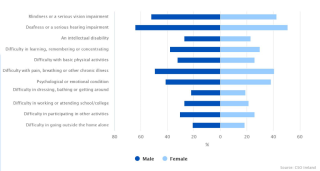
There were 130,067 persons with a disability aged 15 and over at work, accounting for 22.3 per cent of the total disabled working population of 584,045. This compares with 53.4 per cent for the overall population aged 15 and over who were at work. This is slightly lower than what was reported in 2017 ESRI report, Employment transitions among people with disabilities in Ireland. An Analysis of the Quarterly National Household Survey – which put the proportion of the working-age population with a disability in employment at 31 per cent, while those without a disability had an employment rate of 71%.
Chart 4 shows the number and percentage of disabled men and women at work in each age group. The percentage of disabled men at work reached a peak in the 35-39 age group with 51 per cent at work, while female participation peaked in the 30-34 age group at 48.6 per cent. From the ages of 20 to 34, the number of female workers with a disability exceeded their male colleagues, but from age 35 onwards the number of male workers exceeded female workers in both number and proportion of disabled workers. Overall in April 2016, 6.5 per cent of the people at work had a disability. The unemployment rate amongst persons with a disability was 26.3 per cent, over twice the 12.9 per cent rate for the population as a whole. Male unemployment exceeded female unemployment for all disability types with those experiencing a psychological or emotional condition showing the greatest difference at 9.3 per cent.
Chart 4: Number and percentage of people with a disability who were at work, 2016.
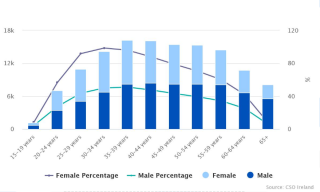
The European Commission Country Report for Ireland 2022 revealed that Ireland has the largest disability employment gap in the EU, at 38.6%. It also noted that less than one third of people with disabilities were employed in 2019.
People with disabilities are still facing considerable challenges, although support is being enhanced. Ireland has one of the lowest employment rates for people with disabilities in the EU (26.2 % compared to 48.1 % in the EU in 2017) and one of the highest gaps between people with and without disabilities (45.1 percentage points). The Comprehensive Employment Strategy for People with Disabilities 2015-2024 aims at increasing the statutory target of 3 % of employees with disabilities in the public sector towards 6 % by 2024. In addition, a EUR 16 million Ability Programme (2018-2021) to invest in the employability of people with disabilities aged 1529 has been announced. Additional funding totalling EUR 150 million has been allocated for disability services in the 2019 budget. How this money will be invested remains to be seen as details have so far not been released on specific measures and programs.
In relation to disability support, the national consultation for ‘early engagement’ and the reconfiguration of the qualifying age for Domiciliary Care Allowance and Disability Allowance payments was conducted with the next steps still to be announced by the Government.
The UN Convention on the Rights of Persons with a Disability was adopted in 2006. Ireland ratified it in 2018, the first Human Rights treaty of the 21st Century and at its core is a commitment to ensure the rights of disabled people to be treated as full and equal citizens.
Article 27 of the UNCRPD "…recognises the right of persons with disabilities to work, on an equal basis with others; this includes the right to the opportunity to gain a living by work freely chosen or accepted in a labour market and work environment that is open, inclusive and accessible to persons with disabilities. States Parties shall safeguard and promote the realisation of the right to work, including for those who acquire a disability during the course of employment, by taking appropriate steps, including through legislation. We can realise that vision by taking a rights-based approach."
We must ensure:
- Eligibility and supports for all employment activation schemes include people with disabilities
- Increased funding for Personal Assistant hours and develop a person-centred approach to allocating those hours
- Fast-track reinstatement of Disability Allowance for those who have accessed employment, but then have to leave
- Resource current strategies.
Social Justice Ireland urges Government to:
- Introduce a cost of disability payment to account for the increased costs associated with living with a disability
- Continued investment in skills, education and training to harness the abilities of people with disabilities.
- Introduce a system of Basic Income to provide a universal “floor” to allow greater flexibility for people living with a disability to access work that suits their abilities and needs.